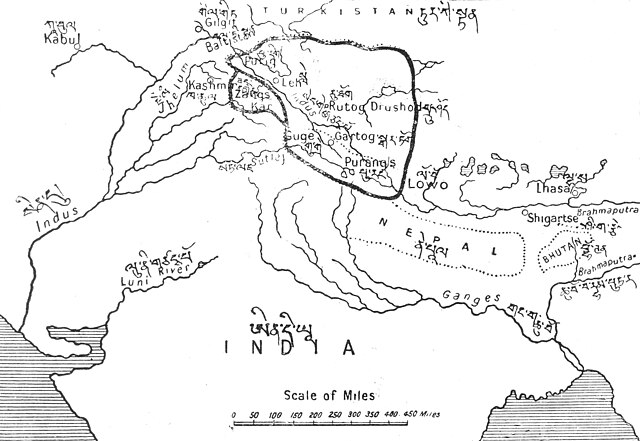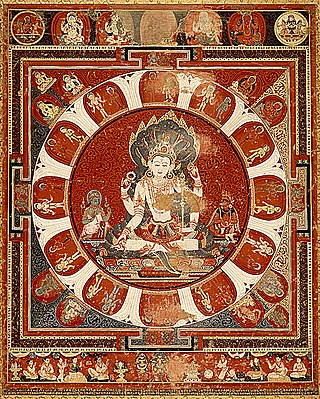Loading AI tools

Ladakh ("land of high passes") is a region in Indian state of Jammu and Kashmir that currently extends from the Kunlun mountain range to the main Great Himalayas to the south, inhabited by people of Indo-Aryan and Tibetan descent. It is one of the most sparsely populated regions in Jammu and Kashmir and its culture and history are closely related to that of Tibet. Ladakh is renowned for its remote mountain beauty and culture.
Ladakh before the birth of the kingdom during the 9th century is scarce. Ladakh can hardly be considered a separate political entity before the establishment of the kingdom about 950 CE, after the collapse of the early Tibetan Empire and the border regions became independent kingdoms under independent rulers, most of whom came from branches of the Tibetan royal family.

Earliest history The earliest layer in the population of Ladakh probably comprised the Dardi. Herodotus twice mentions a people called Dadikai, first along with the Gandarioi, and again in the catalogue of king Xerxes's invasion of Greece. Herodotus also mentions the gold-digging ants of central Asia, which is also mentioned in connection with the Dardi people by Nearchus, the admiral of Alexander, and Megasthenes.
In the 1st century CE, Pliny the Elder repeats that the Dards(Brokpa in Ladakhi) are great producers of gold. Herrmann argues that the tale ultimately goes back to a hazy knowledge of gold-washing in Ladakh and Baltistan.[citation needed] Ptolemy situates the Daradrai on the upper reaches of the Indus, and the name, Darada, is used in the geographical lists of the Puranas.
The first glimpse of political history is found in the kharosthi inscription of "Uvima Kavthisa" discovered near the K'a-la-rtse (Khalatse) bridge on the Indus, showing that in around the 1st century, Ladakh was a part of the Kushan Empire. A few other short Brahmi and Kharosthi inscriptions have been found in Ladakh.

Buddhism in Ladakh is ancient and widespread and a popular theme for cultural tours in Ladakh. The population of Ladakh is predominantly Buddhist and Ladakh has been deeply influenced by Tibetan Buddhism, which follows the Mahayana and Vajrayana schools. In these forms of Buddhism, Buddha is worshipped a deity who has attained Nirvana (freedom from the cycle of birth and death). Various incarnations of Buddha, known as Bodhisattvas, are also worshipped in monasteries. Many tourists undertake trip to Ladakh to explore, understand and learn from the ancient Buddhism which is practiced here.
Dalai Lama: The Buddhists of Ladakh regard His Holiness the Dalai Lama, as their supreme spiritual leader and as living incarnation of Buddha. The present Dalai Lama, who is the 14 Dalai Lama was originally known as Tenzin Gyatso. As a child he was recognized as an incarnation of the previous Dalai Lama, who had passed away in 1933. Tenzing Gyatso was brought to Lhasa and proclaimed the new spiritual leader of the Tibetan people on Feb 22nd 1940.
Due his resistance to the Chinese occupation Tibet, the Dalai Lama became an icon of political as well as spiritual leadership for the Tibetans. The Dalai Lama left Tibet and came to India in March, 1959. Ever since, he has led an international campaign against the Chinese occupation of Tibet. He received the Nobel Prize for Peace in 1989 for his leadership of the struggle for the peaceful liberation of Tibet.

Gompas: A Gompa is a spiritual community where monks or nuns live and practice their religion. Gompas in Ladakh are also educational institutions and play a central role in the life and economy of the local community. Gompas are more than just monasteries and many have museums where tourists can view collections of Buddhist art. The annual festivals in Ladakh are celebration at the Gompas which is a colorful sight with masked dances and religious ceremonies drawing both pilgrims and tourists in large numbers.
Chortens and Stupas: Chortens and stupas are dome shaped structures built over a square base. They are usually built in memory of a Buddhist monk or religious teacher. Some stupas may contain relics of holy men. Chortens are often decorated with Buddhist prayer flags and offerings such as oil lamps or flowers etc may be placed around them.


Thangka: Thangkas are Buddhist religious paintings that depict episodes from the life of Buddha or various Boddhisatvas. Rich in symbolism and Buddhist imagery, Thangkas are religious artifacts and the art of learning to paint a Thangka is a discipline that requires extensive training.
Mandala: A Mandala is a symbolic representation of the Universe according to Buddhist iconography. A colorful design made from sand on the floor of a monastery or painted on a wall or screen, a mandala is believed to have mystical powers that aid in meditation concentration and prayer. Mandalas often depict a palace with four gates, which open to the four principal directions of the Earth. Mandalas are used in the rituals of a monks initiation and are called the 'Architecture of Enlightenment' Mandalas made of sand are usually swept away after a prayer ceremony to symbolize the impermanence of life. The designs of the Mandala follow an ancient tradition and consist of concentric circles and intersecting lines. The process of learning to create a Mandala is part of the training of every Tibetan monk.
Ladakhi culture is similar to Tibetan culture. Ladakhi food has much in common with Tibetan food, the most prominent foods being thukpa (noodle soup) and tsampa, known in Ladakhi as ngampe (roasted barley flour). Edible without cooking, tsampa makes useful trekking food.
Traditional music includes the instruments surna and daman (shenai and drum). The music of Ladakhi Buddhist monastic festivals, like Tibetan music, often involves religious chanting in Tibetan as an integral part of the religion.
Tibetan medicine has been the traditional health system of Ladakh for over a thousand years. This school of traditional healing contains elements of Ayurveda and Chinese medicine, combined with the philosophy and cosmology of Tibetan Buddhism. For centuries, the only medical system accessible to the people have been the amchi — traditional doctors following the Tibetan medical tradition.
Ladakh celebrates many famous festivals. One of the biggest and most popular is the Hemis festival. It is celebrated in June to commemorate the birth of Guru Padmasambhava.
"land of high passes", is a region in the state of Jammu and Kashmir of Northern India sandwiched between the Karakoram mountain range to the north and the Himalayas to the south. The Indian portion of Ladakh is composed of the Leh and Kargil districts. The Leh district is the second largest district of India, covering more than half the area of Jammu and Kashmir, of which it is the eastern part.
Among the popular places of tourist interest include Leh, Drass valley, Razi khar (Chiktan Khar), Suru valley, Kargil, Zangskar, Zangla, Rangdum, Padum, Phukthal, Sani Monastery, Stongdey, Shayok Valley, Sankoo, Salt Valley. Popular treks are Manali to Ladakh, the Nubra valley, Pangong tso, Tso moriri, the Indus valley, Markha valley, Ladakh monastery trek, South Zangskar, Trans-Zangskar Expedition, Spiti to Ladakh, Spiti to Pitok to Hemis, Rupshu, the Great Salt lakes, Chadar Ice trek, Padum-Phuktal, Padam to Darcha
Wikiwand in your browser!
Seamless Wikipedia browsing. On steroids.
Every time you click a link to Wikipedia, Wiktionary or Wikiquote in your browser's search results, it will show the modern Wikiwand interface.
Wikiwand extension is a five stars, simple, with minimum permission required to keep your browsing private, safe and transparent.